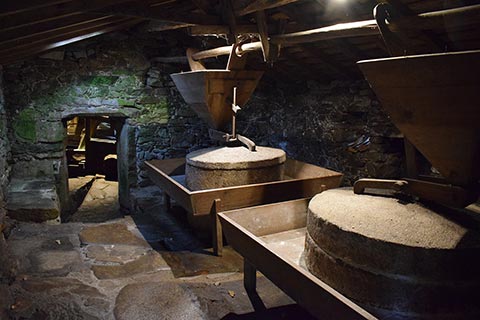It is very common for river mills to be built alongside fulling mills because they take advantage of the force of the same current of water to function. Furthermore in Mosquetín we can see a particularly interesting set of mills due to their number and variety.
There are seven mills in total. There are four negreiros, two albeiros and one relón. The first, named thusly for its black stones, is the most common in A Costa da Morte and in Galicia in general, and were used to grind corn.
The albeiros, or white stone mills, on the other hand, were used in the milling of wheat and were usually made with calcareous or quartzite stones. The base and cover of the albeiro mill above had been originally brought from France, although since the 80s the mills nowadays took advantage of another mill in ruins in the parish of Salto.
The relón mill was used to re-grind wheat bran, sifting it and passing it through the mill again.
It is interesting to note that several of the mills in the south building were powered by the same current of water that moved the wheels of the north construction.
The mills of Mosquetín did not charge in money as was the case with the fulling mills. The clients paid the maquía, which was a payment in kind. It came to be 1 kg per ferrado (a type of volume-based measurement similar to a bushel), taking into account that in the zone the ferrado of corn was 18 kg and that of wheat 13 kg.









